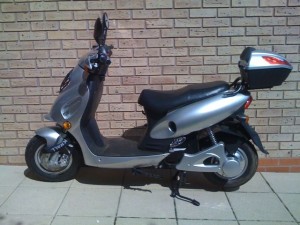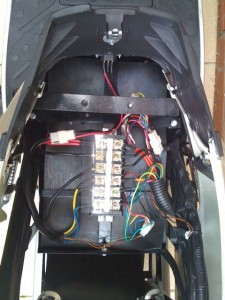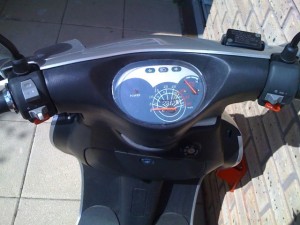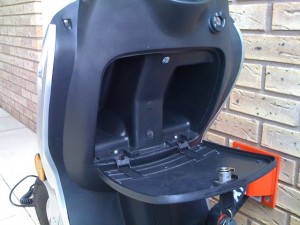Electric scooter
Petrol is fantastic stuff. It’s driven modern society, to the point of defining it: dirty, but very effective. Petrol has been so popular because of it’s convenience - as a liquid it’s easy to handle; and the fantastic amount of energy it holds - about 10 kilowatt hours in each litre. That’s an amazing amount of energy, in a very small space If the chemical energy in petrol could be be turned directly into electricity:
- A teacup full could boil enough water for 114 cups of tea
- A shot glass full could run my laptop for 13 hours. Compared to only 3 hours on battery.
- A petrol pump filling my car at 45 litres/minute would have a power output of 26 megawatts. Enough to power about 58 000 UK homes.
Of course, currently we can’t turn petrol directly into electricity. Instead we run internal combustion engines with it, to power cars and generators. Car engines operate at around 20% efficiency - for every 10 kW hours (1 litre) of fuel burnt, only 2 kW hours (0.2 litres) turn the wheels. The rest is lost as heat. Electric motors are highly efficient. Brushless DC motor are around 85% efficient - for every 10 kW hours of electricity that flow in, 8.5 kW hours turn the wheels. Batteries however, are not nearly so great. The current leader is Lithium ion batteries, which at best achieve up to 0.5 kWh/litre (and more typically 0.25 - 0.3 kWh/l). Petrol is 20 times more energy dense than batteries (by volume). To put it bluntly
- Petrol is a brilliant energy carrier. The internal combustion engine sucks at using that energy.
- The electric motor is a brilliant energy user. Batteries suck, at storing or delivering that energy.
What does this have to do with scooters?
Well, electric cars are just entering the market. To have a 100+ mile range, they must carry hundreds of kilos of batteries. Those batteries is expensive, and in the case of the Mini E consume the back seats. For me, the electric car is not practical yet. Scooters are easier to electrify. They’re lighter, simpler and more practical as a supplement to a petrol car. Because there is less weight to carry, they need only a fraction (perhaps 1/5) of the batteries, so they’re only a fraction of the price.
Eco Machines Electra 2012 Review
In June I bought an Eco Machines Electra 2012 scooter. An electric scooter restricted to 30 mph, with a 2 kW motor in the hub of the rear wheel. The scooter carries 8 lead acid batteries, in 2 parallel strings. Each is 12 V, giving a capacity of 40 AH at 48 V and a quoted range of 30 miles. The cost of the scooter is currently about £1000, plus delivery and a one off registration fee. A full recharge takes 8 hours, and costs no more than 25 pence.
I went for the Electra because the dealer is local to me, and because of the internals. The parallel strings of batteries are to my knowledge unique with in this class of scooter, most use only 4 or 5 batteries. The wiring and motor controller are similarly up rated for better performance. Customer service from Eco Machines was great, they knew their products well. So far I’ve been riding for 2 weeks, on a 16 mile round trip. Overall I’m happy with the scooter. It copes okay with the 40 mph dual-carriageway sections of my route, and fine with city centre streets. Acceleration is good for a 50 cc equivalent, it’s smooth off the line and reaches top speed quickly enough. I would like more acceleration off the line, for when joining large roundabouts from a stand still. Riding a scooter is similar to riding a bicycle, minus the pedals, so experience on one is useful. The front brake is on the right handle bar, and the rear is on the left. The throttle is controlled by twisting the right handle bar, a spring returns it to 0 if the pressure is released. Lights, indicators and the horn are controlled by thumb switches. There are no gears or clutch to worry about, and nothing for your feet to do whilst on the move.
I spend most of my journey at the scooter’s top speed. Without a top-up at work it’s top speed has reduced to about 27 mph by the time I reach home. Like all lead acid scooters, power fades as the battery discharges. I expect that on a scooter with fewer batteries, I would see much greater fade. The ‘fuel gauge’ measures the voltage of the batteries, rather than smoothly decreasing with distance it will droop when under acceleration. The amount of droop indicates the amount of charge left - more droop, less charge.
I’ve had no problems with the included charger, which has an aluminium housing that feels robust. I’m able to leave it unattended, as it switches off once it senses charging has completed. The charger fits in the under-seat storage with room to spare. Although the ignition switch suggests The Electra also has a glove box with enough space for a pair of gloves and some waterproofs. Mine came with a top box mounted behind the seat, this had sufficient space for an open face helmet, but not a full face helmet. The glove box and under-seat storage open with the ignition key, the top box uses a second key. The headlights are suitable for urban use. To be more visible, I run them during the day as well as night time. I wouldn’t ride this scooter on unlit roads. The horn is nice and loud. The steering is responsive, the instruments are clear, and the front disc brake/rear drum brake are good enough for my needs Overall I’m happy with the purchase, particularly as a gadget to tinker with. If Eco Machines had offered it, I would have gone for lithium ion batteries. When it comes time to replace the batteries, I shall look in to making the switch.
Electric Scooter Costs
The purchase price, and the electricity to run an electric scooter are not the only costs to be budgeted for. You should budget at least £500, for protective clothing and ancillary items. The following one off costs are compulsory or highly advisable:
| Item | Description | Price range |
|---|---|---|
| Helmet | Required by law for protection. A proper fit is essential, so be fitted in person by somebody experienced. Don't buy second hand or by mail order. Price alone does not determine level of protection. | £50 - £500+ |
| Number plate | Required by law. Must adhere to regulation size/lettering. Proof of registration required | £10 - £20 |
| Tax disc holder | Required to display tax disc | £15 - £20 |
| Gloves | Strongly Advised for comfort and protection. Sturdy leather on the palms and fingers is important | £10 - £80 |
| Jacket | Advised for comfort and protection. Leather or polyester fabric with 'CE armour' shoulder and elbow pads. Some have thermal and waterproof lining | £60 - £300+ |
| CBT | Compulsory Basic Training required by law unless a pre-2001 car licence holder, but then still strongly advised. Lasts 1 day, teaches the basics | £90 - £120 |
| Trousers | Advised for comfort and protection. Leather or polyester, with 'CE armour' knee pads and padding. Some have thermal and waterproof lining | £45 - £250 |
| Boots | Advised for protection and comfort. Leather with reinforced ankle and sole, waterproof. | £50 - £180+ |
| Chain/lock | Advised, to deter thieves. A chain/padlock and/or disc-lock. Sold Secure or Thatcham approved ones may reduce insurance. | £20 - £150+ |
| Ground anchor | Optional. Provides a secure attachment point for a chain. Sold Secure or Thatcham approved ones may reduce insurance. | £10 - £150 |
Items other than the helmet could be bought second hand, to bring down the cost. The following recurring costs must also be budgeted for:
| Item | Description | Price range |
|---|---|---|
| Insurance | Required by law. Price is highly variable. Claim history, address and other factors determine price. Car NCD usually doesn't transfer. | £100+ / year |
| Batteries | Necessary. To replace worn out lead acid cells. | £XXX / 500 full charges |
Electric Scooter Tips
- Don’t take specifications such as range at face value. Most range figures are optimistic, or quoted under ideal conditions at low speeds. Hills and stop-start traffic will reduce you range significantly.
- Get to know the dealer and their warranty/after sales support. Are you confident in the support they can provide?
- For an idea of the dealers in the UK, visit the A to B electric motorcycle price guide.
- Take photocopies of your licence, licence counterpart and any documentation, before sending them with the V55 registration form to DVLA.
- Consider where you will keep a scooter, and how you will plug it in to charge. Is there room to manoeuvre, and if necessary to perform a 3 point turn?
- Outside charging is possible, by running the cable through a nearby window, or having a weather proof IP66 socket on an external wall.
- Insurance can be arranged the same day over the phone, and registration may take weeks to complete, so wait until registration documents are received before taking out insurance. A list of insurers thread mentions some electric scooter insurers.
- Take CBT whether it’s required or not, and further training as you see fit. On 2 wheels you are more vulnerable, and inexperienced. The Motorcycle Training Beginners Guide has more information
- Experience with a car does not automatically make you experienced on 2 wheels. In fact some car instincts are counter productive on 2 wheels.
- Pay attention on the road, and don’t ride in the gutter. Treat everything as a potential threat when riding.
- Pay particular attention in wet weather. Roads become very slippery on 2 wheels, in such condition.
- In Birmingham (unlike London, where there are currently trials) motorcycles and scooters are not automatically allowed to use bus lanes. However many bus lanes are marked for motorcycle use.
- Ask questions. Here, at the Electric Transport forum or at Bike Chat Forums.





